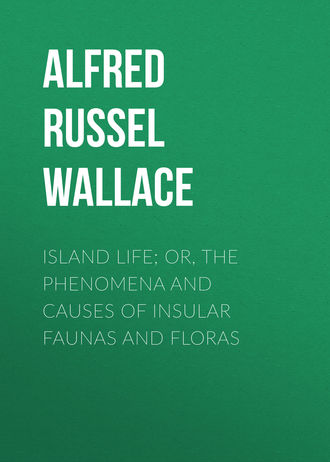 полная версия
полная версияIsland Life; Or, The Phenomena and Causes of Insular Faunas and Floras
This passage is evidently written by a person familiar with the phenomena of glaciation, and as Captain Aylward's preface is dated from Edinburgh, he has probably seen similar markings in Scotland. The country described consists of the most extensive and lofty plateau in South Africa, rising to a mountain knot with peaks more than 10,000 feet high, thus offering an appropriate area for the condensation of vapour and the accumulation of snow. At present, however, the mountains do not reach the snow-line, and there is no proof that they have been much higher in recent times, since the coast of Natal is now said to be rising. It is evident that no slight elevation would now lead to the accumulation of snow and ice in these mountains, situated as they are between 27° and 30° S. Lat.; since the Andes, which in 32° S. Lat. reach 23,300 feet high, and in 28° S. Lat. 20,000, with far more extensive plateaus, produce no ice-fields. We cannot, therefore, believe that a few thousand feet of additional elevation, even if it occurred so recently as indicated by the presence of striations, would have produced the remarkable amount of glaciation above described; while from the analogy of the northern hemisphere, we may well believe that it was mainly due to the same high excentricity that led to the glaciation of Western and Central Europe, and Eastern North America.
These observations confirm those of Mr. G. W. Stow, who, in a paper published in the Quarterly Journal of the Geological Society (Vol. XXVII. p. 539), describes similar phenomena in the same mountains, and also mounds and ridges of unstratified clay packed with angular boulders; while further south the Stormberg mountains are said to be similarly glaciated, with immense accumulations of morainic matter in all the valleys. We have here most of the surface phenomena characteristic of a glaciated country, only a few degrees south of the tropic; and taken in connection with the indications of recent glaciation in New Zealand, and those discovered by Dr. R. von Lendenfeld in the Australian Alps between 6,000 and 7,000 feet elevation (Nature, Vol. XXXII. p. 69), we can hardly doubt the occurrence of some general and wide-spread cause of glaciation in the southern hemisphere at a period so recent that the superficial phenomena are almost as well preserved as in Europe. Other geologists however deny that there are any distinct indications of glacial action in South Africa; but the recent discovery by Dr. J. W. Gregory, F.G.S., of the former extension of glaciers on Mount Kenya 5,000 feet below their present limits, renders probable the former glaciation of the South African Highlands.
60
The astronomical facts connected with the motions and appearance of the planet are taken from a paper by Mr. Edward Carpenter, M.A., in the Geological Magazine of March, 1877, entitled, "Evidence Afforded by Mars on the Subject of Glacial Periods," but I arrive at somewhat different conclusions from those of the writer of the paper.
61
In an article in Nature of Jan. 1, 1880, the Rev. T. W. Webb states that in 1877 the pole of Mars (? the south pole) was, according to Schiaparelli, entirely free of snow. He remarks also on the regular contour of the supposed snows of Mars as offering a great contrast to ours, and also the strongly marked dark border which has often been observed. On the whole Mr. Webb seems to be of opinion that there can be no really close resemblance between the physical condition of the Earth and Mars, and that any arguments founded on such supposed similarity are therefore untrustworthy.
62
London, Edinburgh and Dublin Philosophical Magazine, Vol. XXXVI., pp. 144-150 (1868).
63
Climate and Time in their Geological Relations, p. 341.
64
Nature, Vol. XXI., p. 345, "The Interior of Greenland."
65
Prof. J. W. Judd says: "In the case of the Alps I know of no glacial phenomena which are not capable of being explained, like those of New Zealand, by a great extension of the area of the tracts above the snow-line which would collect more ample supplies for the glaciers protruded into surrounding plains. And when we survey the grand panoramas of ridges, pinnacles, and peaks produced for the most part by sub-aërial action, we may well be prepared to admit that before the intervening ravines and valleys were excavated, the glaciers shed from the elevated plateaux must have been of vastly greater magnitude than at present." (Contributions to the Study of Volcanoes, Geological Magazine, 1876, p. 536.) Professor Judd applies these remarks to the last as well as to previous glacial periods in the Alps; but surely there has been no such extensive alteration and lowering of the surface of the country since the erratic blocks were deposited on the Jura and the great moraines formed in North Italy, as this theory would imply. We can hardly suppose wide areas to have been lowered thousands of feet by denudation, and yet have left other adjacent areas apparently untouched; and it is even very doubtful whether such an extension of the snow-fields would alone suffice for the effects which were certainly produced.
66
Geological Magazine, 1876, p. 392.
67
Colonel Fielden thinks that these trees have all been brought down by rivers, and have been stranded on shores which have been recently elevated. See Trans. of Norfolk Nat. Hist. Soc., Vol. III., 1880.
68
Geological Magazine, 1876, "Geology of Spitzbergen," p. 267.
69
The preceding account is mostly derived from Professor Heer's great work Flora Fossilis Arctica.
70
Geological Magazine, 1875, p. 531.
71
Geological Magazine, 1876, p. 266. In his recent work—Climate and Cosmology (pp. 164, 172)—the late Dr. Croll has appealed to the imperfection of the geological record as a reply to these arguments; in this case, as it appears to me, a very unsuccessful one.
72
It is interesting to observe that the Cretaceous flora of the United States (that of the Dakota group), indicates a somewhat cooler climate than that of the following Eocene period. Mr. De Rance (in the geological appendix to Capt. Sir G. Nares's Narrative of a Voyage to the Polar Sea) remarks as follows: "In the overlying American Eocenes occur types of plants occurring in the European Miocenes and still living, proving the truth of Professor Lesquereux's postulate, that the plant types appear in America a stage in advance of their advent in Europe. These plants point to a far higher mean temperature than those of the Dakota group, to a dense atmosphere of vapour, and a luxuriance of ferns and palms." This is very important as adding further proof to the view that the climates of former periods are not due to any general refrigeration, but to causes which were subject to change and alternation in former ages as now.
73
Mr. S. B. J. Skertchley informs me that he has himself observed thick Tertiary deposits, consisting of clays and anhydrous gypsum, at Berenice on the borders of Egypt and Nubia, at a height of about 600 feet above the sea-level; but these may have been of fresh-water origin.
74
By referring to our map of the Indian Ocean showing the submarine banks indicating ancient islands (Chap. XIX.), it will be evident that the south-east trade-winds—then exceptionally powerful—would cause a vast body of water to enter the deep Arabian Sea.
75
In his recently published Lectures on Physical Geography, Professor Haughton calculates, that more than half the solar heat of the torrid zone is carried to the temperate zones by ocean currents. The Gulf Stream itself carries one-twelfth of the total amount, but it is probable that a very small fraction of this quantity of heat reaches the polar seas owing to the wide area over which the current spreads in the North Atlantic. The corresponding stream of the Indian Ocean in Miocene times would have been fully equal to the Gulf Stream in heating power, while, owing to its being so much more concentrated, a large proportion of its heat may have reached the polar area. But the Arctic Ocean occupies less than one-tenth of the area of the tropical seas; so that, whatever proportion of the heat of the tropical zone was conveyed to it, would, by being concentrated into one-tenth of the surface, produce an enormously increased effect. Taking this into consideration, we can hardly doubt that the opening of a sufficient passage from the Indian Ocean to the Arctic seas would produce the effects above indicated.
76
For an account of the resemblances and differences of the mammalia of the two continents during the Tertiary epoch, see my Geographical Distribution of Animals, Vol. I. pp. 140-156.
77
Professor Haughton has made an elaborate calculation of the difference between existing climates and those of Miocene times, for all the places where a Miocene flora has been discovered, by means of the actual range of corresponding species and genera of plants. Although this method is open to the objection that the ranges of plants and animals are not determined by temperature only, yet the results may be approximately correct, and are very interesting. The following table which summarizes these results is taken from his Lectures on Physical Geography (p. 344):—

It is interesting to note that Iceland, which is now exposed to the full influence of the Gulf Stream, was only 12°.6 F. warmer in Miocene times, while Mackenzie River, now totally removed from its influence was 28° warmer. This, as well as, the greater increase of temperature as we go northward and the polar area becomes more limited, is quite in accordance with the view of the causes which brought about the Miocene climate which is here advocated.
78
The objection has been made, that the long polar night would of itself be fatal to the existence of such a luxuriant vegetation as we know to have existed as far as 80° N. Lat., and that there must have been some alteration of the position of the pole, or diminution of the obliquity of the ecliptic, to permit such plants as magnolias and large-leaved maples to flourish. But there appears to be really no valid grounds for such an objection. Not only are numbers of Alpine and Arctic evergreens deeply buried in the snow for many months without injury, but a variety of tropical and sub-tropical plants are preserved in the hot-houses of St. Petersburg and other northern cities, which are closely matted during winter, and are thus exposed to as much darkness as the night of the Arctic regions. We have besides no proof that any of the Arctic trees or large shrubs were evergreens, and the darkness would certainly not be prejudical to deciduous plants. With a suitable temperature there is nothing to prevent a luxuriant vegetation up to the pole, and the long continued day is known to be highly favourable to the development of foliage, which in the same species is larger and better developed in Norway than in the south of England.
79
Geological Magazine, 1873, p. 320.
80
Geological Magazine, 1877, p. 137.
81
Manual of Geology, 2nd Ed. p. 525. See also letter in Nature, Vol. XXIII. p. 410.
82
Nature, Vol. XVIII. (July, 1878), p. 268.
83
"On the Comparative Value of certain Geological Ages considered as items of Geological Time." (Proceedings of the Royal Society, 1874, p. 334.)
84
Trans. Royal Society of Edinburgh, Vol. XXIII. p. 161. Quarterly Journal of Science, 1877. (Croll on the "Probable Origin and Age of the Sun.")
85
Philosophical Magazine, April, 1853.
86
It has usually been the practice to take the amount of denudation in the Mississippi valley, or one foot in six thousand years, as a measure of the rate of denudation in Europe, from an idea apparently of being on the "safe side," and of not over-estimating the rate of change. But this appears to me a most unphilosophical mode of proceeding and unworthy of scientific inquiry. What should we think of astronomers if they always took the lowest estimates of planetary or stellar distances, instead of the mean results of observation, "in order to be on the safe side!"? As if error in one direction were any worse than error in another. Yet this is what geologists do systematically. Whenever any calculations are made involving the antiquity of man, it is those that give the lowest results that are always taken, for no reason apparently except that there was, for so long a time, a prejudice, both popular and scientific, against the great antiquity of man; and now that a means has been found of measuring the rate of denudation, they take the slowest rate instead of the mean rate, apparently only because there is now a scientific prejudice in favour of extremely slow geological change. I take the mean of the whole; and as this is almost exactly the same as the mean of the three great European rivers—the Rhone, Danube, and Po—I cannot believe that this will not be nearer the truth for Europe than taking one North American river as the standard.
87
"On the Height of the Land and the Depth of the Ocean," in the Scottish Geographical Magazine, 1888.
88
These figures are merely used to give an idea of the rate at which denudation is actually going on now; but if no elevatory forces were at work, the rate of denudation would certainly diminish as the mountains were lowered and the slope of the ground everywhere rendered flatter. This would follow not only from the diminished power of rain and rivers, but because the climate would become more uniform, the rainfall probably less, and no rocky peaks would be left to be fractured and broken up by the action of frosts. It is certain, however, that no continent has ever remained long subject to the influences of denudation alone, for, as we have seen in our sixth chapter, elevation and depression have always been going on in one part or other of the surface.
89
The following statement of the depths at which the Palæozoic formations have been reached in various localities in and round London was given by Mr. H. B. Woodward in his address to the Norwich Geological Society in 1879:—

We thus find that over a wide area, extending from London to Ware and Harwich, the whole of the formations from the Oolite to the Permian are wanting, the Cretaceous resting on the Carboniferous or older Palæozoic rocks; and the same deficiency extends across to Belgium, where the Tertiary beds are found resting on Carboniferous at a depth of less than 400 feet.
90
Geological Magazine, Vol. VIII., March, 1871.
91
Mr. C. Lloyd Morgan has well illustrated this point by comparing the generally tilted-up strata denuded on their edges, to a library in which a fire had acted on the exposed edges of the books, destroying a great mass of literature but leaving a portion of each book in its place, which portion represents the thickness but not the size of the book. (Geological Magazine, 1878, p. 161.)
92
Professor J. Young thinks it highly probable that—"the Lower Greensand is contemporaneous with part of the Chalk, so were parts of the Wealden; nay, even of the Purbeck a portion must have been forming while the Cretaceous sea was gradually deepening southward and westward." Yet these deposits are always arranged successively, and their several thicknesses added together to obtain the total thickness of the formations of the country. (See Presidential Address, Sect. C. British Association, 1876.)
93
Mr. John Murray in his more careful estimate makes it about 51½ millions.
94
As by far the larger portion of the denuded matter of the globe passes to the sea through comparatively few great rivers, the deposits must often be confined to very limited areas. Thus the denudation of the vast Mississippi basin must be almost all deposited in a limited portion of the Gulf of Mexico, that of the Nile within a small area of the Eastern Mediterranean, and that of the great rivers of China—the Hoang Ho and Yang-tse-kiang, in a small portion of the Eastern Sea. Enormous lengths of coast, like those of Western America and Eastern Africa, receive very scanty deposits; so that thirty miles in width along the whole of the coasts of the globe will probably give an area greater than that of the area of average deposit, and certainly greater than that of maximum deposit, which is the basis on which I have here made my estimates. In the case of the Mississippi, it is stated by Count Pourtales that along the plateau between the mouth of the river and the southern extremity of Florida for two hundred and fifty miles in width the bottom consists of clay with some sand and but few Rhizopods; but beyond this distance the soundings brought up either Rhizopod shells alone, or these mixed with coral sand, Nullipores, and other calcareous organisms (Dana's Manual of Geology, 2nd Ed. p. 671). It is probable, therefore, that a large proportion of the entire mass of sediment brought down by the Mississippi is deposited on the limited area above indicated.
Professor Dana further remarks: "Over interior oceanic basins as well as off a coast in quiet depths, fifteen or twenty fathoms and beyond, the deposits are mostly of fine silt, fitted for making fine argillaceous rocks, as shales or slates. When, however, the depth of the ocean falls off below a hundred fathoms, the deposition of silt in our existing oceans mostly ceases, unless in the case of a great bank along the border of a continent."
95
From the same data Professor Haughton estimates a minimum of 200 million years for the duration of geological time; but he arrives at this conclusion by supposing the products of denudation to be uniformly spread over the whole sea-bottom instead of over a narrow belt near the coasts, a supposition entirely opposed to all the known facts, and which had been shown by Dr. Croll, five years previously, to be altogether erroneous. (See Nature, Vol. XVIII., p. 268, where Professor Haughton's paper is given as read before the Royal Society.)
96
See Geological Magazine for 1877, p. 1.
97
In his reply to Sir W. Thomson, Professor Huxley assumed one foot in a thousand years as a not improbable rate of deposition. The above estimate indicates a far higher rate; and this follows from the well-ascertained fact, that the area of deposition is many times smaller than the area of denudation.
98
Dr. Croll and Sir Archibald Geikie have shown that marine denudation is very small in amount as compared with sub-aërial, since it acts only locally on the edge of the land, whereas the latter acts over every foot of the surface. Mr. W. T. Blanford argues that the difference is still greater in tropical than in temperate latitudes, and arrives at the conclusion that—"If over British India the effects of marine to those of fresh-water denudation in removing the rocks of the country be estimated at 1 to 100, I believe that the result of marine action will be greatly overstated" (Geology and Zoology of Abyssinia, p. 158, note). Now, as our estimate of the rate of sub-aërial denudation cannot pretend to any precise accuracy, we are justified in neglecting marine denudation altogether, especially as we have no method of estimating it for the whole earth with any approach to correctness.
99
Agassiz appears to have been the first to suggest that the principal epochs of life extermination were epochs of cold; and Dana thinks that two at least such epochs may be recognised, at the close of the Palæozoic and of the Cretaceous periods—to which we may add the last glacial epoch.
100
This view was, I believe, first put forth by myself in a paper read before the Geological Section of the British Association in 1869, and subsequently in an article in Nature, Vol. I. p. 454. It was also stated by Mr. S. B. J. Skertchley in his Physical System of the Universe, p. 363 (1878); but we both founded it on what I now consider the erroneous doctrine that actual glacial epochs recurred each 10,500 years during periods of high excentricity.
101
Explication d'une seconde édition de la Carte Géologique de la Terre (1875), p. 64.
102
For most of the facts as to the zoology and botany of these islands, I am indebted to Mr. Godman's valuable work—Natural History of the Azores or Western Islands, by Frederick Du Cane Godman, F.L.S., F.Z.S., &c., London, 1870.
103
See Chap. V. p. 78.
104
Some of Mr. Darwin's experiments are very interesting and suggestive. Ripe hazel-nuts sank immediately, but when dried they floated for ninety days, and afterwards germinated. An asparagus-plant with ripe berries, when dried, floated for eighty-five days, and the seeds afterwards germinated. Out of ninety-four dried plants experimented with, eighteen floated for more than a month, and some for three months, and their powers of germination seem never to have been wholly destroyed. Now, as oceanic currents vary from thirty to sixty miles a day, such plants under the most favourable conditions might be carried 90 X 60 = 5,400 miles! But even half of this is ample to enable them to reach any oceanic island, and we must remember that till completely water-logged they might be driven along at a much greater rate by the wind. Mr. Darwin calculates the distance by the average time of flotation to be 924 miles; but in such a case as this we are entitled to take the extreme cases, because such countless thousands of plants and seeds must be carried out to sea annually that the extreme cases in a single experiment with only ninety-four plants, must happen hundreds or thousands of times and with hundreds or thousands of species, naturally, and thus afford ample opportunities for successful migration. (See Origin of Species, 6th Edition, p. 325.)
105
The following remarks, kindly communicated to me by Mr. H. N. Moseley, naturalist to the Challenger, throw much light on the agency of birds in the distribution of plants:—"Grisebach (Veg. der Erde, Vol. II. p. 496) lays much stress on the wide ranging of the albatross (Diomedea) across the equator from Cape Horn to the Kurile Islands, and thinks that the presence of the same plants in Arctic and Antarctic regions may be accounted for, possibly, by this fact. I was much struck at Marion Island of the Prince Edward group, by observing that the great albatross breeds in the midst of a dense, low herbage, and constructs its nest of a mound of turf and herbage. Some of the indigenous plants, e.g. Acæna, have flower-heads which stick like burrs to feathers, &c., and seem specially adapted for transposition by birds. Besides the albatrosses, various species of Procellaria and Puffinus, birds which range over immense distances may, I think, have played a great part in the distribution of plants, and especially account, in some measure, for the otherwise difficult fact (when occurring in the tropics), that widely distant islands have similar mountain plants. The Procellaria and Puffinus in nesting, burrow in the ground, as far as I have seen choosing often places where the vegetation is the thickest. The birds in burrowing get their feathers covered with vegetable mould, which must include spores, and often seeds. In high latitudes the birds often burrow near the sea-level, as at Tristan d'Acunha or Kerguelen's Land, but in the tropics they choose the mountains for their nesting-place (Finsch and Hartlaub, Orn. der Viti- und Tonga-Inseln, 1867, Einleitung, p. xviii.). Thus, Puffinus megasi nests at the top of the Korobasa basaga mountain, Viti Levu, fifty miles from the sea. A Procellaria breeds in like manner in the high mountains of Jamaica, I believe at 7,000 feet. Peale describes the same habit of Procellaria rostrata at Tahiti, and I saw the burrows myself amidst a dense growth of fern, &c., at 4,400 feet elevation in that island. Phaethon has a similar habit. It nests at the crater of Kilauea, Hawaii, at 4,000 feet elevation, and also high up in Tahiti. In order to account for the transportation of the plants, it is not of course necessary that the same species of Procellaria or Diomedea should now range between the distant points where the plants occur. The ancestor of the now differing species might have carried the seeds. The range of the genus is sufficient."









